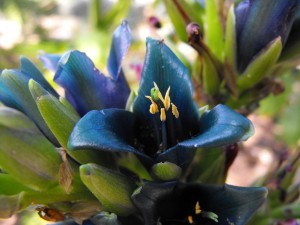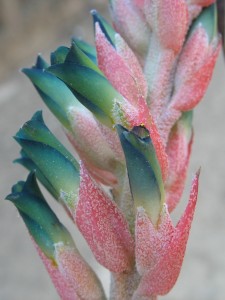Puya: The Hardy Bromeliad
Author: Celeste Booth6 Comments
Care and Culture, Classification

Puya is a very large genus of bromeliad, both in number of species and in size of plant. The genus includes the world’s largest species of bromeliad the Puya ramondii which grows up to 30 feet tall and 9 feet across. There are about 199 species within the Puya genus.
Puyas: Natural Range
Puyas are hardy because of where they grow naturally. They are found in the high elevations of the Andes Mountains throughout South America. Only two species found in Costa Rica are not included in the South American range. In this region the climate is typically dry and temperatures can drop below freezing. Puyas must be hardy to thrive in such extreme climates.
Unlike most bromeliads Puyas are terrestrial, growing in the ground instead of growing as epiphytes in trees. They have roots that take up nutrients and water from the soil as opposed to the air.
Form
Many Puyas have long, spiked leaves that form in a round, ball-like rosette. Many Puyas resemble yuccas, agave and other succulent plants, but they are not related to one another. Puyas adjust to arid conditions by suspending their growth while true succulents store water in their tissues.
A Unique Characteristic
Possibly the most interesting fact about Puyas is that some are protocarnivourous. This means that animals can become trapped and entangled in their spines. They die while trapped. Then, as they decompose they provide nutrients for the plants through the soil. Many of the plants also have spines that act as protection from grazing animals.
Puyas grow very large, but slowly. Puyas often take years and even decades to produce a flower. Many species of Puya produce giant flower spikes that grow very tall and produce hundreds of flowers. They are monocarpic, meaning they produce only one flower spike and eventually die. Before they die they will produce many offsets and the plants usually grow in large colonies.
Growth Requirements
Puyas like plenty of sun and water during the summer growing season and require dry soil during cold temperatures. They can survive temperatures as low as 18 degrees for a time. This feature makes them an ideal plant for growing outdoors in many parts of the United States that will not support other more fragile bromeliads.
One disadvantage of Puyas is their size. It may be difficult to find space within a garden or landscape to house a mature Puya. Puyas are have stiff leaves and sharp spines making them a bit more difficult to manage. In many cases Puya’s unique form and attractive flowers make them worth the extra effort to include in a bromeliad collection.
Common Species
While the genus is abundant with species, not many are grown for cultivation in the United States. However, there are a few that can be found in botanical gardens. There are also seeds and starts available from specialty retailers. Here are a few of the more common Puya species:
Puya mirabalis
Puya mirabalis has dense grass-like leaves. They are narrow and flexible, but have very sharp spines. The leaves form a ball shaped clump. This plant typically reaches maturity between one and two years and will produce a flower stalk at that time. The flower stalk is tall and stands erect above the center of the plant. The flowers are spaced about an inch or two apart. They are lime green and droop down from the stalk.
Puya tuberosa
The Puya Tuberosa is a small plant compared to most Puyas. It only grows about 20 inches wide and 20 inches tall. This makes it a more practical Puya for indoor collections. The plant is native to Bolivia. It has silvery leaves that form a sparse rosette. Like most Puyas the tubular shaped leaves have sharp spines around the margins. A spike rises above the center of the plant and produces purple flowers with orange pollen. This plant is available from online specialty retailer, Tropiflora.
Puya dyckioides
This Puya is similar to bromeliads in the Dyckia genera from which it derives its name. It comes from Argentina, found at around 10,000 feet. It is known to withstand temperatures down to 12 degrees. It has dark green glossy leaves that are jagged with spikes. The flower spike can rise up to 30 inches from the base of the plant. It has clusters of pink inflorescence that produce small turquoise blue flowers. This plant is available from online retailer, Plant Delights Nursery, Inc.
Puya yakespala
This is a large Puya that grows about three feet wide, but when allowed to grow with its offsets can create large mats. It produce a spectacular flower spike that can grow up to eight feet tall. The pinkish gray inflorescence stands out at nearly 90 degree angles from the flower spike. They produce clusters of bright lime green flowers. The plant has silvery green leaves that stand erect with spines around the margins. This bizarre flowering plant is available from online retailer, Plant Delights Nursery, Inc.

-Puya alpestris
Puya alpestris
Puya alpestris grows about two feet tall and two feet wide. It has narrow, dark green leaves with large teeth surrounding the leaf margin. It has a flower spike that rises from the center of the plant and produces brilliant blue flowers. This plant can be purchased from online retailer, Annie’s Magic Garden.
Puya berteroniana
This Puya is also called the turquoise Puya. It is known for its giant flower spike that produces clusters of large, brilliant turquoise flowers. The flowers also have bright orange anthers. This same species has a form that produces bright blue flowers also. The Puya berteroniana grows up to four feet across and tall and can take between six and eight years to reach mature flowering size. The plant requires full sun, but it is hardy down to 18 degrees. This plant is available from online retailer, Strange Wonderful Things.
Tips to Remember
There are a few things to keep in mind as you consider adding Puyas to your bromeliad collection. Puyas do best outside in full sun conditions. Many Puyas are hardy down to several degrees below freezing. However, young Puyas should be protected from frost. Puyas also require very dry soil in the winter. Make sure the Puyas are placed in a well drained area and will not be exposed to too much water during the dormant season. Most Puyas like plenty of water during the summer growing season.
Puyas make great landscape plants in arid regions. They are also excellent container plants in just about any region. If the weather in the winter becomes too cold or too wet, simply move the container to a protected area. With a little patience the Puya’s bizarre and brilliant inflorescence will be very rewarding. Consider how you could include a Puya in your collection.
Sources
“Plant Files: Puya.” Dave’s Garden. <http://davesgarden.com/guides/pf/go/67082/>
“Puya alpestris” Annies Magic Garden. <http://www.anniesmagicgarden.com/product.php?productid=17630&cat=253&page=1>
“Puya dyckioides (Dyckia-like Hardy Bromeliad)” Plant Delights Nursery, Inc. <http://www.plantdelights.com/Puya-dyckioides-Dyckia-like-Hardy-Bromeliad/productinfo/9512/#.UYf2dJW0dpY>
“Puya tuberosa” Tropiflora. <http://www.tropiflora.com/shop.cfm?page=display&ProductID=54433&CategoryID=46&Genus=Puya&iPageNbr=1&src=genus>
“Puya yakespala (Yakespala Hardy Bromeliad)” Plant Delights Nursery, Inc. <http://www.plantdelights.com/Puya-yakespala-Yakespala-Hardy-Bromeliad/productinfo/9843/#.UYf4fpW0dpY>
“The Turquoise Puya” Strange Wonderful Things. <http://www.strangewonderfulthings.com/101.htm>
6 Responses to “Puya: The Hardy Bromeliad”
Leave a Reply

Resource Download
Hechtia Care Cheat Sheet
Learn how to care for your Hechtia bromeliad with this quick and easy informational guide.
Learn More
Ask an Expert
Questions about bromeliads?
Our experts love a challenge!
Photo of the Week
Submit your photo to be featured on the blog!
More Photo of the Week Winners
Submit Photo









no one of the photos are bromeliads
How strange, you’re right! Not sure why those were included in the post. We’ll be updating them today. Thanks for the good eye 😉
Need help with Puya laxis? I can send pictures. These are my late husband’s plants. I have lost all but one.
These are drought tolerant plants, so I’d first make sure you aren’t over-watering them. Think of them like caring for a cactus.
Mine is getting ready to bloom. Been waiting 20 years!
Puya alpestris can also be purchased online from Annie’s Annuals.